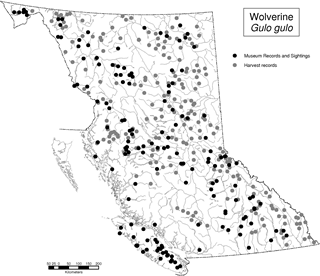Wolverines are good dispersers. COSEWIC (2003) says "Wolverines are able
to traverse rugged terrain, including tundra and glaciers that would act as barriers to
many species of mammals. Dispersal characteristics likely gave wolverines the
capacity to recolonize gaps in their distribution in Scandinavia (Vangen et al. 2001). However, long distance movements place individuals at greater risk of mortality due to predation, trapping, accident or starvation (Copeland 1996).
The large home range size of wolverines increases its susceptibility." Wolverines have an excellent sense of smell, which is important in scavenging.
|
The reproductive rate of wolverines is considered relatively low (COSEWIC 2003). Lofroth (2004) says "Wolverines breed between late April and early
September but embryos do not implant until
January. Sometime between late February and mid-
April, females give birth to between one and five
cubs. They nurse for 8–9 weeks after which they
leave the den but stay with mother for their first
winter learning to hunt. Young disperse in spring.
Natal dens are often underground.".
|
Wolverines are scavengers and predators and are opportunistic feeders that both hunt and eat carrion (COSEWIC 2003). Diet includes rodents, snowshoe hares, birds, and young ungulates. Researchers have shown, however, that small mammals and birds were relatively unimportant in Wolverine diet in their study areas (Lofroth et al. 2007). Snowshoe Hares are important in the diet of the Wolverine (COSEWIC 2003). Carrion may include caribou, moose, mountain sheep, mountain goats, deer, elk, fish and marine mammals. Wolverines will also eat plants, including berries. Researchers in BC have shown that caribou and marmots are important to denning females, and that marmots are important to adult females during the summer (COSEWIC 2003, Lofroth et al. 2007). Lofroth et al. (2007) carried out studies of Wolverine diet in BC.
|
Home range size varies for males (230-1580 km2) and females (50-400 km2), with the largest home ranges reported for dispersing adult males (avg. 3500 km2) (COSEWIC 2003). At higher elevations, females burrow into snow in February to create a den and this is used until May when the young are weaned. Success of dens is depended on late snow melt (snow provides insulation) and a nearby food source.
|
|
